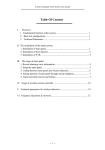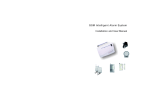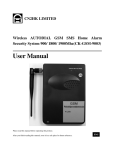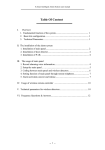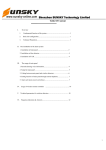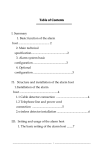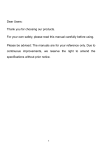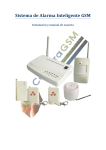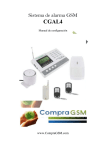Download Table Of Content
Transcript
GSM Intelligent Alarm System user manual Table Of Content I. General overview 1. Fundamental function of the system.................................................................. 1 2. Basic kits configuration..................................................................................... 1 3. Technical Parameters: ....................................................................................... 2 II. The installation of the alarm system 1. Installation of main host.................................................................................... 3 2. Installation of door detector............................................................................... 4 3. Installation of P.I.R. .......................................................................................... 4 III. The usage of main host 1. Setting Alarm phone number ............................................................................ 5 2. Setting alarm message…………....................................................................... 6 3. Coding between main host and wireless detectors………………….………....6 4. Parameters Setting of main host........................................................................ 7 5. Usage of wireless remote controller……………………………………….....8 6. The LEDs on the main host.............................................................................. 9 IV. The basic usage guide……………................................................................ 10 V. Frequency Questions & Answers................................................................... 11 Appendix Technical parameters for wireless detectors....................................... 12 -- 1 -- GSM Intelligent Alarm System user manual I. General Overview Thanks for selecting the GSM alarm system, please read the user manual carefully before installation and operation. 1. Fundamental function of the system 1) Support multi GSM bands, This host suits for: GSM900/DCS1800 MHz GSM850/900/DCS1800/1900 MHz 2) The main host has the option which supports Alarm center , please check when selecting, this host: Does not support alarm center Supports Ademco Contact ID alarm center Supports short message alarm center 3) No need of fixing telephone line. It is very suitable for cottage, house, shop, garage, wherever GSM Network is presented. 4) When the alarm is activated, user could select: both dialing number and sending short message, only dialing, only sending message or neither dialing nor sending message. 5) Easy to setup alarm phone numbers and sending messages through SMS. 6) Supports up to 7 wired and 28 wireless detectors. 7) Indicates up to 30 Activated Zone numbers when alarming and coding. 8) Set the system state (Arm, Disarm etc.) by remote telephone or SMS. 9) Have the option to set arm delay and alarm delay mode. 10) Have the option to send confirm siren sound in arm or disarm state. 11) Onsite voice Monitoring through telephone in long distance. 12) Support two wired sirens, of which one is onboard socket, and the other is wired terminals. 13) One onboard relay available for customer application. 14) One port could work as collector output or +12V power supply for wired detectors. 2. Basic configuration kits Main host (with antenna) Power supply 1 set 1 pc -- 2 -- GSM Intelligent Alarm System user manual Wireless P.I.R. 1 pc Wireless Door detector 1 set Remote controller 2 pcs External siren 1 pc User manual 1 pc Optional: backup battery, wireless smoke detector, gas detector, infrared curtain sensor, panic button etc. Figure1. main host of the alarm system 3. Technical Parameters: 1) 2) Power supply: Static Current: AC110V/220V ~ DC12V 1A < 12mA(without battery charging current) 3) GSM transmission power: CLASS4(2W)/EGSM850/900, 4) 5) Wireless frequency: Wireless Modulation: 6) Wireless receive sensitivity:-95dBm@12dB SINAD 7) 8) 9) Support defense zone: Volume of siren: Working temperature: CLASS1(1W)/DCS1800/1900 433.92 MHz (or 315 MHz if specified) ASK 35 ≥110dBspl -20℃ ~ +55℃ -- 3 -- R.H.≤90% GSM Intelligent Alarm System user manual II. The installation of the alarm system 1. Installation of main host The main host should be installed firmly when there is GSM signal and power supply, no additional wired connection needed. 1 8 2 7 3 6 4 5 Figure2. external interface in the rear of main host. ① ② ③ ④ ⑤ ⑥ ⑦ ⑧ Backup battery (optional) switch, the battery could keep the system work a few hours without external power supply. External power supply socket, DC 12V/1A, inner Anode. Wired siren socket. External 12 pins interface, see Note 3. SIM card, eject the tray by pressing the yellow button, push it back after putting the card into the tray. Registration press key: through which Arm Out detectors could make the registration (coding) with the main host. Reset/Registration press key: through which Arm Home detectors could make the registration(coding) with the main host; It also works as the system reset function, pressing the key when power on, all system parameters would be set to default (factory setting). Antenna Port, connect antenna before operation, Keep the antenna in vertical for better performance. -- 4 -- GSM Intelligent Alarm System user manual Note 3: External 12 pins interface, from left to right: Pin 1: Common ground. Pin 2: Siren output positive, negative is connected to common ground. Pin 3: Output terminal, or +12V power supply output selecting by one on board jumper. Pin 4 to Pin 10 are wired input terminals, of which each is composed of common ground, Self adapt alarm activated, that is more than 100ms level change in the working situation would activate the alarm. Pin 11 and Pin 12 are the input and output terminals of onboard relay. Closed when Relay is on, and open when it is off. Wired siren Relay input Relay output collector output +12V power 7 channel wired detector input Figure3. connection of external ports 2. Installation of door detector From the principle of Magnetic Door/Window detector: When the gap of magnet and Magnetron is increased to a certain distance, the magnetism decreases accordingly and the switch in the Magnetron turns on and results from alarming. It can detect the opening of doors and windows. Magnet part is easy to be installed on doors or windows, the other part then fixed on the door frames by adhesive tape, the activated gap is 8 ~ 15mm. -- 5 -- GSM Intelligent Alarm System user manual 3. Installation of P.I.R. PIR could detect body in the certain range. Detection distance is from 5 to 12 meters (adjustable), Horizontal detection angle is 110 degrees, and vertical detection angle is 60 degrees. Adjust the direction and distance to the suitable Position, and then fix the PIR on the wall or the furniture. Please be noted: the position and direction of the PIR would affect the detection performance, please contact your suppliers if you meet difficulties when make the in installation. III. The usage of main host 1. Setting alarm telephone numbers User must set alarm phone(or alarm center) numbers in SIM card by the user name A1 to A7 before using it, when alarms activated, main host would dial the alarm numbers from A1 to A7 and send alarm message in turn. Save to the SIM card directly through the mobile phone: Put the SIM card into one GSM cell phone and save alarm phone numbers in SIM card, by the name from A1 to A7 respectively. No longer than 20 digits for each number, no “+” needed for international numbers, no country code for domestic numbers. Setup through the short message Sending short message to main host number with the format: ****#A1(A2/A3/A4/A5/A6,A7)# ######## In this manual, if there is no particular declaration, “****” represents 4 digits access password, default is “1234”, “#A1#” (A1-A7) represent alarm phone No., two “#” are must. “########” represents valid 8 digits phone number, “XXXXXXXXXX” represents text characters, For example: 1234#A1#88888888 Setting the number “88888888” to A1 -- 6 -- GSM Intelligent Alarm System user manual Please pay attention: If the main host supports alarm center, then A1, A2 would be saved to Alarm center phone numbers, and A3-A7 are 5 Alarm phone number. 2. Setting alarm messages The alarm message is the corresponding text information(SMS) sent to user mobile phones which preserved in the main host when this zone alarm is activated, those messages are created by the main host by the default format “ 1(2-35) zone activated” in the initialization process. 1 to 7 are wired zone, 8-35 are wireless zone Also user could set the alarm message by modifying the corresponding text in mobile phone or sending short message by the following format: ****#SM#1(2-35)XXXXXXXXXX For example: “1234#SM#5 wired zone is alarming”, Then the message“5 wired zone is alarming” would save to SIM card as the alarm message. Note: 1) The digits 1-35 in the head of each message is the must, otherwise they would not be corresponded to wired and wireless alarm zone numbers. The length of each message is no more than 100 letters, the exceeded parts would be probably missed. 2) All messages are saved into SIM card, the host would only deal with message 1 to 18 if the messages capability of the card is 20. 3. Coding (Registration) between main host and wireless detectors Detectors (except remote controllers and emergency detectors) would be registered to the main host by two mode: Arm at home, and Arm Out. In arm at Home state, the detectors registered by Arm at home mode could not activate the alarm, such as indoor infrared detectors. In arm Out state, all the registered detectors could activate the alarm. Whatever state the main host in, any registered emergent detectors (Smoking and Gas leakage detectors etc.) are activated, the main host would make the alarm immediately. -- 7 -- GSM Intelligent Alarm System user manual Registration at Arm Out mode Press “Code” key for 2s, release and then press again, after one beep, the system is in coding (out) mode, and then user make detectors registered, after finishing coding, Press “Code” key again, the main host ends coding process with one beep. Registration at Arm Home mode press “Reset” key for 2s, release and then press again, after one beep, the system is in coding (at home) state, and then user make detectors registered, after finishing coding, Press “Reset” key again, the main host ends coding process with one beep. Remark: In coding mode, “Reset” key works as “code at home” key. Modify the arm mode or Remove the registered detectors User could change detectors state from arm at home (or out) to arm out(at home) freely just by one registration out(at home) mode process. Pressing Reset key when power on would remove all registered detector. 4. Parameters Setting of main host 1) Set by remote telephone User dial the main host number, after answered, input “****#”(password and“#”, the default password is 1234) by pressing the keys of the talking phone, after one beep, then user could make the following configuration through pressing keys. 0# Arm (default) 0* Disarm 1# Alarm delay 35S 1* Alarm delay 0S 2# Enable phone call when alarming (default) 2* Disable phone call when alarming 3# Enable Siren make sound when the main host is in Arm/Disarm statue 3* Disable Arm/Disarm Siren sound (default) 4# Relay closed 4* Relay opened (default) 5# Sends SMS when alarm is activated (default) 5* Does not send SMS when alarm is activated -- 8 -- GSM Intelligent Alarm System user manual 6# 7# 7* 8# ****# 9# 9* Attention: 1. 2. Release alarming, main host ends the current alarm and phone connection. Siren make alarm sound when alarm is activated (default) No siren sound when alarm activated Change to new password**** Disable onsite monitoring (default) Enable onsite monitoring Each operation is ended with “#”or “*”, one beep indicates one successful action, no beep indicates the action is invalid, please check and try again. If the main host supports the Alarm center, the following setting would be: 2# Reports arm/disarm status to alarm center Enable (for hosts support alarm center) 2* Does not report the status to alarm center (default) 3# **** # Set the host ID(****) (for hosts support alarm center) 2) Set by short message User could Send SMS to main host number to set function with the following format: 1) ****XXXXXXXX [,XXXXXXXX] (Content of SMS), Set main host status, the content of SMS includes: ARM DISARM RELAY ON RELAY OFF eg: “1234ARM, RELAY OFF” Represents setting main host Arm, relay on (closed) 2) Set new password to “6789” 1234#PW#6789 3) Setting the number “13888888888” to A3 (alarm telephone). 1234#A3#138888888 4) Setting the message“1 external input alarm” to SIM card. 1234#SM#1 external input alarm 5) Set main host ID “0008” if the main host supports alarm center 1234#ID#0008 -- 9 -- GSM Intelligent Alarm System user manual 5. Usage of wireless remote controller The remote controller has three buttons or four buttons: Arm out Button , or Arm at home button , Disarm Button ,and Panic Button . Press Arm out (or arm at home) Button, main host would be in arm out (or arm at home) state after about 30s delay. Press arm out (or arm at home) followed by panic button would get into arm out (or arm at home) state immediately (instant arm). Press Panic button would activate the alarm, Press Disarm button would release or cancel the alarm at any time. 6. The LEDs on the main host 1) Output indicator (OUT): lit when output high level. 2) Input indicator (INPUT): lit when any of input from IN1 to IN7 activated. 3) Relay indicator (RELAY): lit when inside relay closed. 4) Siren indicator (SIREN): lit when siren is sounding. 5) Monitor indicator (MONITOR): lit when get into onsite monitor state. 6) GSM signal indicator (SIGNAL): blinked when searching GSM signal and talk, lit in standby, extinguished if there are no signal or valid alarm phone numbers. Power supply led(POWER) Output led(OUT) Input led(IN) Arm/disarm status (STATUS) Relay status led(RELAY) GSM, card status (SIGNAL) Monitor status(MONITOR) Siren status led(SIREN) Figure 4. LEDs in the front panel --- 10 -- GSM Intelligent Alarm System user manual 7) Status indicator (STATUS): lit when armed, extinguished for disarmed, blinked for alarming and delay arm. 8) Power indicator (POWER): lit when power on. 9) Zone indicator(ZONE ID): “8”LEDs on the top right corner of host represents the zone numbers, display “1 - 9”and “A - F”, digit “1-7”represent external wired input zone I1 to I7, “8-F” represents wireless zone 8-15, “1-F” with the lit point “.” represents wireless zone 16-30. IV. The basic usage guide 1)The installation of main host and detectors Mount the antenna, connect the wired detectors properly, and relay if available, input SIM card, and plug in power supply etc. 2) Set the alarm phone number and alarm message either edit SIM directly or through short message. 3) Make wireless detectors and remote controller registration to the main host according the above procedure. 4) Alarm Activated A. Main host is in out arm status, any level change in the wired input terminal I1 to I7, any wireless activated signal from registered detectors. B. Main host is in at home arm status, any level change in the wired input terminal I1 to I7, any wireless activated signal from arm home detectors. C. Any emergency signal from registered detectors for example smoking and Gas leakage detectors. D. Pressing panic button of registered remote controller. 5) Valid answer/release alarm When alarm activated, the siren sounds, main host sends alarm message, and dial alarm phone number continuously up to 5 times if there is no valid answer or release action. --- 11 -- GSM Intelligent Alarm System user manual If user answer the alarm call, after entering the valid password, pressing “6#” would release this alarm, also user could press disarm button of the remote controller to cancel the current alarming. Frequency Questions & Answers Q1: Main host can’t dial when alarming is activated Answer: A. Make sure SIM card in working condition B. Set the alarm phone number correctly C. Make sure the detectors work normally D. Make sure the correct setting parameters when alarm is activated Q2: Fail to set alarm phone number or alarm message by short message Answer: A. Make the format of short message is correct. B. Make sure the access password is valid or reset to default 1234. Q3: Can’t setup or control through telephone in long distance Answer: A. Make sure the access password is valid, when input the valid password, one “Di” beep to confirm or reset to default 1234. B. Too fast key pressing results in unstable system detect, please press the key firmly and not slowly. Q4: Wired detectors could not work incorrectly Answer: A. Make the connection correctly according to the manual B. The wired detector would be ready after 60S of power on, before that the status maybe unstable. Q5: The main host could not alarm when detector is activated. Answer: A. Make sure if the main host set in arm delay mode B. Make sure the wireless detectors are registered --- 12 -- GSM Intelligent Alarm System user manual Appendix. Technical parameters for wireless detectors 1. Wireless gap (door/window) Detector Power supply: DC = 12V~8.4V(inner battery DC=12V) Static Current: I1 ≤ 15μA Transmission Current: I2 ≤ 15mA Transmission Frequency: f = 315/433.92 ±0.2MHz Transmission Time: T ≥ 1S Transmission Distance: No Obstacle ≥ 80m; Internal distance: 8 ~ 15mm Working Temperature: -10℃~+40℃ Relative Humidity: ≤ 90% 2. Wireless P.I.R. Detector Power supply: Static Current: Transmission Current: Transmission Frequency: Transmission Time: Transmission Distance: Preheating Time: Interval of twice Emission: Detected Distance: Detected Angle: Working Condition: Relative Humidity: Static Current: DC = 9V~7.2V(inner battery DC=9V) I1 ≤ 30μA I2 ≤ 20mA f = 433.92 (or 315)±0.2MHz T ≥ 1s No Obstacle ≥ 80m ≤ 2min.30s ≤ 35s 5~12m Horizontal: 110°,Vertical: 60° Temperature: -10℃~+40℃ ≤ 90% I1 ≤30μA Transmission Current: I2≤20mA Transmission Frequency: f=315/433.92 ±0.2MHz 3. Wireless Remote Controller Power supply: DC = 12V~8.4V Static Current: I1= 0 Transmission Current: I2 ≤ 15mA Transmission Frequency: f = 315/433.92 ±0.2MHz Transmission Time: T ≤ 1s Transmission Distance: No Obstacle ≥ 80m Working Condition: Temperature: -10℃~ +40℃ Relative Humidity: ≤ 90% --- 13 --













